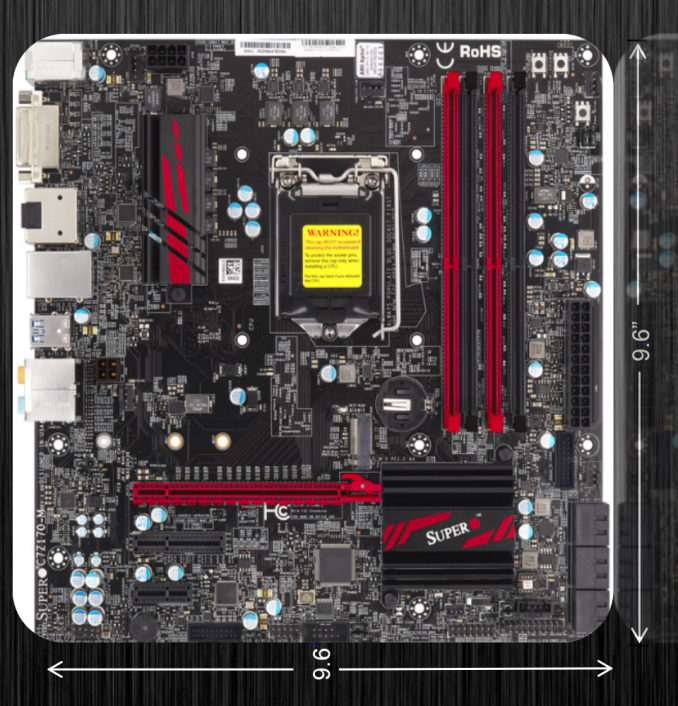Intel Skylake Z170 Motherboards: A Quick Look at 55+ New Products
by Ian Cutress on August 5, 2015 7:59 AM ESTSupermicro Z170
When you mention a consumer motherboard, the name Supermicro does not shout loud from the rooftops. Supermicro is more commonly associated in the server industry with a large chunk of market share for providing enterprise platforms that power a number of industries and government departments. Technically they have had consumer motherboard products now for a couple of years, sticking with a low number of models to test the waters. Supermicro relies more on the name of the brand and the engineer expertise in the server space to carry their product forward. For Z170, they have informed me that at this point two models are in the works although there are some final decisions to be made particularly about coloring and style, so the following pictures may not represent final product.
Supermicro C7Z170-SQ
The SQ is the ATX model, with Supermicro using the red and black color scheme of other Gaming lines to apply it to their own brand.
Here is what looks like a mid-range motherboard sporting an x8/x4/x4 PCIe 3.0 layout in red with x4/x1/x1 in the other black slots from the chipset. The PCIe layout is slightly different to other mainstream boards by virtue of the M.2 slot above them which operates in PCIe 3.0 x4 mode. Because of the arrangement, it means we have a sub-optimal PCIe card placement for dual GPU setups, whereby the top two red PCIe lanes are used which does not leave a ventilation gap which is usually important in a consumer design.
In terms of hardware support, we get six SATA ports, a single USB 3.1 Type-C port on the rear panel due to an ASMedia ASM1142 controller, an Intel I219-V network port and a Realtek ALC1150 audio solution. Unlike some other boards we get a couple of server features, such as TPM and SATA DOM, as well as all five fan headers on board being 4-pin. It will be interesting to see how Supermicro has developed its BIOS and software especially in light of the stiff competition of the regular consumer motherboard manufacturers in this area
Supermicro C7Z170-M
The M is for micro-ATX, and it looks like Supermicro is aiming at something more for the cost conscious user here:
For graphics there is a single PCIe 3.0 x16 slot and no second slot like other micro-ATX motherboards for a second card. Instead we get a fixed with PCIe 3.0 x4 slot and a PCIe x1 slot for good measure. Other functionality is similar to that of the full sized motherboard with six SATA ports, an Intel I219-V for network, a Realtek ALC1150 audio codec and an M.2 slot running in PCIe 3.0 x4 mode. Where the micro-ATX differs is in the power delivery heatsinks and this time the USB 3.1 capabilities have shifted from a single Type-C to two Type-A ports.
At this point pricing for these boards is unknown but a sample of the C7Z170-SQ just came in through the door. We will be testing it in due course.


















85 Comments
View All Comments
utmode - Wednesday, August 5, 2015 - link
Why so many sata express in so many motherboard?Dahak - Wednesday, August 5, 2015 - link
Yeah, I dont get that either, it does not seem like anyone is doing sata express drives, when NVMe is about to come out. Although its only wasting board space as the SateExpress port can double as 2xSATA ports. I was kinda hoping they would have dropped it for this. Maybe on the other chipsets?Kristian Vättö - Wednesday, August 5, 2015 - link
I think the reason lies in the marketing departments wanting to tick a box in the marketing materials. When one manufacturer includes it, everyone follows the suit so their products won't look "inferior" compared to competitors'. It's no secret that SATA Express is practically dead (although I would say it's a miscarriage), but to those with less technical knowledge it may sound cool and better than regular SATA, even though they will end up using SATAe as regular SATA.Ian Cutress - Wednesday, August 5, 2015 - link
ASRock have their USB 3.1 front panel which uses SATA Express, so there's finally some use for it.silenceisgolden - Wednesday, August 5, 2015 - link
It would work better for marketing departments if they market that they "did not bother with the useless standard, SATA Express".DanNeely - Wednesday, August 5, 2015 - link
The design cycle for these boards probably started a good year ago. By the time it became clear that Sata-Express was a dead standard it was too late to make any major design changes for the initial wave of boards.Slash3 - Sunday, August 9, 2015 - link
As someone with 10 SATA devices, I very much appreciate I/O overkill. :)phorgan1 - Monday, December 21, 2015 - link
You can get more sata in less lanes. Once you use up lanes for nvme drives and graphics cards, the smaller groupings won't support more cards or nvme drives (cards need x8 or x16 and nvme drives need x4) the left overs will support usb and sata. Since sata is such lower bandwidth you can still fit a lot of sata in around the fringes, so why not? A sata ssd is still pretty fast.prophet001 - Wednesday, August 5, 2015 - link
Why no slot for M.2 drives?prophet001 - Wednesday, August 5, 2015 - link
Nevermind. Hadn't fully read the article.